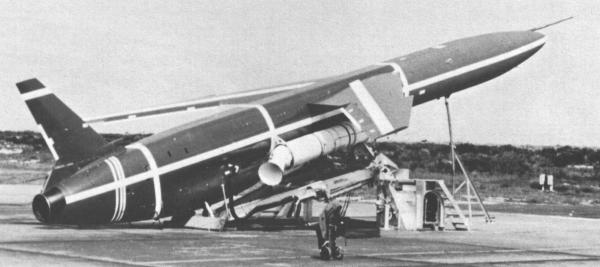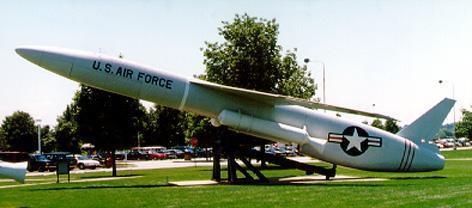Northrop SSM-A-3/B-62/SM-62 Snark
The Snark was the only intercontinental surface-to-surface cruise missile ever deployed by the U.S. Air Force, but was operational for only a very short time because it was already made obsolete by the new ICBMs.
In October 1945 the U.S. Army Air Force began an ambitious long-term program to study and develop a large family of guided missiles, and in January 1946, Northrop submitted designs for turbojet-powered long-range cruise missiles. In March 1946, the USAAF awarded Northrop a development contract for project MX-775, covering the subsonic Snark (MX-775A) and the supersonic SSM-A-5 Boojum (MX-775B). In late 1947, the missile designator SSM-A-3 was assigned to the Snark. Initially the first flight tests of the XSSM-A-3 (Northrop Model N-25) were scheduled for 1949, but because of a reduced project priority and technical difficulties, the first successful launch (after two failures) did not occur before April 1951.
 |
| Photo: Northrop |
| XSSM-A-3 |
The XSSM-A-3 was powered by an Allison J33-A-31 turbojet, and launched from a rocket-powered sled. It had a radio-command guidance system, and was controlled in flight by commands from a DB-45 director aircraft. The XSSM-A-3 could be recovered with the help of a skid-type landing gear and a drag chute.
During its flight test program in 1951, the XSSM-A-3 validated the basic aerodynamic design of the Snark. However, by that time the USAF had significantly increased range and payload requirements for Snark, which lead to a revised and enlarged design, the Northrop Model N-69. The N-69 was powered by an Allison J71 turbojet, and launched from the ground by two solid-propellant rocket boosters. Also in 1951, the Air Force started to assign aircraft designations to its guided missiles, and the Snark became the B-62. The initial XB-62 models (N-69A and N-69B) were performance test missiles, which validated the basic flight characteristics of the new Snark design. These tests began in August 1953, and although a similar recovery system as in the XSSM-A-3 was used, only few N-69A/Bs survived their missions to fly again. The designation QB-62A had been allocated in 1952, and it's possible that it referred to recoverable Snark prototypes. The XB-62 warhead delivery test vehicle (N-69C) began to test the terminal dive characteristics in September 1954. However, initial tests showed that the planned supersonic dive was unfeasable because of control and stability problems. The alternative was to use a detachable nose section which would be separated from the main airframe for a supersonic ballistic drop on the target. Modified N-69C vehicles first tested the new delivery method in September 1955.
 |
| Photo: Northrop |
| XSM-62 (N-69C) |
In early 1955, the Air Force introduced a new designation system for its guided missiles, and the XB-62 was redesignated as XSM-62. The projected XRB-62 reconnaissance version, which was later cancelled, became the XRSM-62.
The J71 turbojet of the N-69A/B/C showed to be troublesome and not up to specifications. It was therefore replaced by a Pratt & Whitney J57 in subsequent N-69D/E models, which were designated XSM-62A. The N-69D (which was recoverable like the N-69A/B), tested the Snark's guidance system, and first flew in November 1955. The SM-62 was to use a 24-hour (day/night) stellar-inertial navigation system, where the INS information is updated by tracking the relative position of bright stars. The N-69D was the first model to use underwing fuel tanks to test the guidance system at full range. However, the system had numerous reliability and accuracy problems, and all Snark test flights over a distance of more than 3400 km (2100 miles) averaged a CEP of no less than 20 miles! Even the most accurate shot came down more than 7.5 km (4.7 miles) from the target, which was barely acceptable even for a missile with a thermonuclear warhead in the megaton class.
 |
| Photo: Rob Svirskas, CCAFS Virtual Tour |
| XSM-62A (N-69D) |
The last test model was the N-69E (possibly designated YSM-62A), which served as the prototype of the production Snark. The N-69E flight program ran from June 1957 to September 1958, and included the first Snark flight to a range of more than 8000 km (5000 miles). Further guidance test flights of N-69D missiles followed until the test program ended in December 1959.
In early 1959, the USAF activated its first (and eventually only) Snark missile wing, and the first SM-62A production missiles, fitted with a W-39 thermonuclear warhead (4 MT), were delivered in May that year. The first SM-62A launch occurred in November 1959, and in February 1961, the unit was declared fully operational with 30 deployed missiles.
 |
| Photo: © Mark Wade, Encyclopedia Astronautica |
| SM-62A |
The severe reliability and accuracy limitations of the SM-62A, together with its significantly larger vulnerability to air defenses when compared to ballistic missiles, meant that the Snark could never be more than an interim emergency weapon. However, in 1961 the SM-65/CGM-16 Atlas ICBM was already operational and the larger SM-68/HGM-25 Titan in advanced development, making the Snark an obsolete system. Therefore the USAF's only Snark unit was deactivated in June 1961. About 100 N-69/SM-62 missiles of all versions were built.
Specifications
Note: Data given by several sources show slight variations. Figures given below may therefore be inaccurate!
Data for XSSM-A-3, SM-62A:
| XSSM-A-3 | SM-62A | |
|---|---|---|
| Length | 15.82 m (51 ft 11 in) | 20.93 m (68 ft 8 in) |
| Wingspan | 12.95 m (42 ft 6 in) | 12.86 m (42 ft 2.4 in) |
| Height | 3.78 m (12 ft 5 in) | 4.52 m (14 ft 10 in) |
| Weight (w/o booster) | 12700 kg (28000 lb) | 22500 kg (49600 lb); booster: 5150 kg (11365 lb) |
| Speed | Mach 0.85 | Mach 0.94 |
| Ceiling | 13700 m (45000 ft) | 18300 m (60000 ft) |
| Range | 2500 km (1550 miles) | 9650 km (6000 miles) |
| Propulsion | Allison J33-A-31 turbojet; 20.4 kN (4600 lb) | Pratt & Whitney J57-P-17 turbojet; 51.1 kN (11500 lb) Booster: 2x Allegany Ballistics solid-fueled rocket; 580 kN (130000 lb) for 4 s each |
| Warhead | none | W-39 thermonuclear (4 MT) |
Main Sources
[1] James N. Gibson: "Nuclear Weapons of the United States", Schiffer Publishing Ltd, 1996
[2] Bill Gunston: "The Illustrated Encyclopedia of Rockets and Missiles", Salamander Books Ltd, 1979
[3] Kenneth P.Werrell: "The Evolution of the Cruise Missile", Air University Press, 1985
[4] Fred Anderson: "Northrop. An Aeronautical History", Northrop, 1976
Back to Directory of U.S. Military Rockets and Missiles, Appendix 1
Last Updated: 12 January 2006